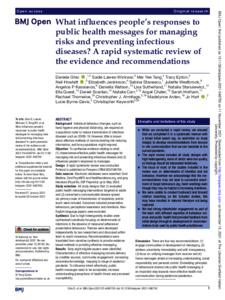GHIO, Daniela, LAWES-WICKWAR, Sadie, TANG, Mei Yee, EPTON, Tracy, HOWLETT, Neil, JENKINSON, Elizabeth, STANESCU, Sabina, WESTBROOK, Juliette, KASSIANOS, Angelos P., WATSON, Daniella, SUTHERLAND, Lisa, STANULEWICZ, Natalia, GUEST, Ella, SCANLAN, Daniel, CARR, Natalie, CHATER, Angel, HOTHAM, Sarah, THORNELOE, Rachael, ARMITAGE, Christopher J., ARDEN, Madelynne, HART, Jo, BYRNE-DAVIS, Lucie and KEYWORTH, Christopher
(2021).
What influences people's responses to public health messages for managing risks and preventing infectious diseases? A rapid systematic review of the evidence and recommendations.
BMJ Open, 11 (11).
[Article]
Documents
29158:596225
![[thumbnail of Thorneloe-WhatInfluencesPeople's(VoR).pdf]](https://shura.shu.ac.uk/29158/8.hassmallThumbnailVersion/Thorneloe-WhatInfluencesPeople%27s%28VoR%29.pdf)

Preview
Abstract
Background Individual behaviour changes, such as hand hygiene and physical distancing, are required on a population scale to reduce transmission of infectious diseases such as COVID-19. However, little is known about effective methods of communicating risk reducing information, and how populations might respond.
Objective To synthesise evidence relating to what (1) characterises effective public health messages for managing risk and preventing infectious disease and (2) influences people’s responses to messages.
Design A rapid systematic review was conducted. Protocol is published on Prospero CRD42020188704.
Data sources Electronic databases were searched: Ovid Medline, Ovid PsycINFO and Healthevidence.org, and grey literature (PsyarXiv, OSF Preprints) up to May 2020.
Study selection All study designs that (1) evaluated public health messaging interventions targeted at adults and (2) concerned a communicable disease spread via primary route of transmission of respiratory and/or touch were included. Outcomes included preventative behaviours, perceptions/awareness and intentions. Non-English language papers were excluded.
Synthesis Due to high heterogeneity studies were synthesised narratively focusing on determinants of intentions in the absence of measured adherence/preventative behaviours. Themes were developed independently by two researchers and discussed within team to reach consensus. Recommendations were translated from narrative synthesis to provide evidence-based methods in providing effective messaging.
Results Sixty-eight eligible papers were identified. Characteristics of effective messaging include delivery by credible sources, community engagement, increasing awareness/knowledge, mapping to stage of epidemic/pandemic. To influence intent effectively, public health messages need to be acceptable, increase understanding/perceptions of health threat and perceived susceptibility.
Discussion There are four key recommendations: (1) engage communities in development of messaging, (2) address uncertainty immediately and with transparency, (3) focus on unifying messages from sources and (4) frame messages aimed at increasing understanding, social responsibility and personal control. Embedding principles of behavioural science into public health messaging is an important step towards more effective health-risk communication during epidemics/pandemics.
Actions (login required)
 |
View Item |



 Tools
Tools Tools
Tools